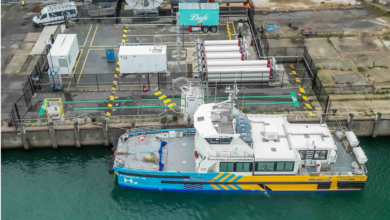AqualisBraemar partners CMAL’s Hyseas III project
AqualisBraemar LOC and its sister company Longitude Engineering will support CMAL in the Hyseas III project.

AqualisBraemar LOC (independent global energy and marine consultancy) partnered with Caledonian Maritime Assets Ltd. (CMAL) (a Scottish public organisation that owns the ferries, ports, harbours and infrastructure for the ferry services) for designing an emission-free hydrogen fuel cell seagoing passenger and car ferry.
The project is part of Hyseas III, which will develop, construct, test and validate data in a full-sized drive train on land. The project is funded by Horizon 2020.
The Hyseas III consortium is composed of:
- Arcsilea (England)
- Ballard (Denmark)
- CMAL (Scotland)
- Interferry (Sweden)
- Kongsberg Gruppen (Norway)
- McPhy (France)
- Orkney Isles Council (Scotland)
- St Andrew University (Scotland)
The project follows Hyseas-I and Hyseas-II, intending to build on the previous projects’ findings by showing that fuel cells can be integrated with a proven marine hybrid electric drive system (electric propulsion, control gear, batteries etc.), with hydrogen storage and bunkering provisions.
AqualisBraemar will be responsible for designing a double-ended seagoing passenger and car ferry to be driven by a hydrogen-powered drive train.
Hydrogen will be supplied from Shapinsay in Orkney where it is generated by using wind power. The ferry will carry 16 cars or two trucks and 120 passengers.
AqualisBraemar operations in Aberdeen will be involved in working with CMAL. It will also use its sister company, Longitude Engineering’s expertise to support the Hyseas III project.
Graham Dallas, Business Development Manager for AqualisBraemar LOC in Europe, said, “AqualisBraemar LOC understand the important role the maritime industry has to play in the global fight for climate change.”
John Salton, Fleet Manager and Projects Director at CMAL, says: “Hydrogen ferries exist, but this concept is built around using hydrogen fuel cells to power a seagoing ship, the first in the UK and Europe. If successful, the next step will be to take the knowledge and know-how into building a ferry.”
